Plasma Fairies: Femtosecond Laser Holograms
August 18, 2015
Imagine a three-dimensional aerial hologram that you can feel. You won’t have to imagine it for long; it’s real! Scientists in Japan have created it, but at the moment these holograms are no bigger than 5 cm3.
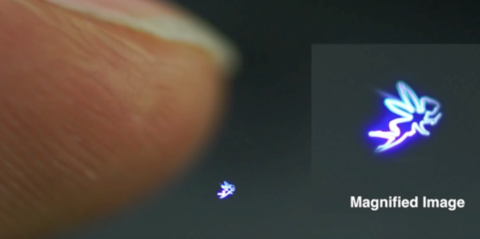
Images from Youtube video Fairy Lights in Femtoseconds: Aerial and Volumetric Graphics Rendered by Focused Femtosecond Laser Combined with Computational Holographic Fields.
Image Credit: Yoichi Ochia et al. (full video is embedded in this article).
Lighting Up Voxels
To create an aerial hologram, you need to have a medium to work with — something that will either reflect or emit light at precise locations throughout a given volume, creating a three dimensional image of an object. The researchers chose a very common medium, air, and did something less common with it: turning it to plasma. You’ve seen air emit light when lightning strikes — it requires ionizing the air — ripping some of the electrons off of air molecules (and often breaking molecular bonds) creating a plasma — a set of unbound charged particles, that overall is electrically neutral. As the electrons reattach themselves to the air particles and “fall” back to their lowest energy state, they emit electromagnetic radiation, much of which is not visible. The light that we can see from plasma created in air appears whitish-blue with hints of purple.
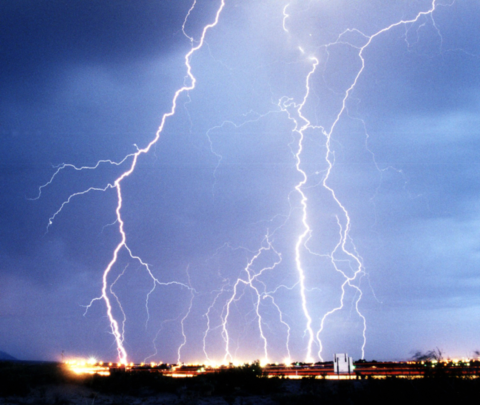
Lightning occurs when electrons from ionized air molecules (air plasma) return back to their lowest energy states.
By focusing a laser very precisely, the researchers managed to create a tiny, isolated volume of plasma. These voxels, as they’re called, are the 3D equivalent of pixels; just as “pixel” stands for “picture element”, a “voxel” is a “volume element” — the basic building block of a 3D display.
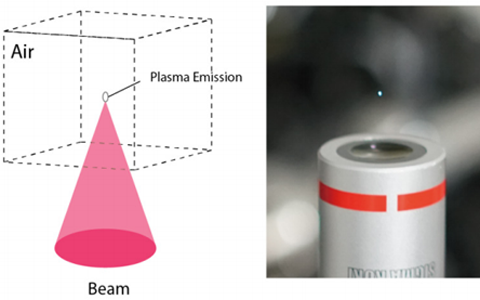
A focused laser creates a single voxel of plasma.
Image Credit: Yoichi Ochia et al.
In the past, nanosecond (billionth of a second) laser pulses were used to create aerial plasma. While these worked, the energy associated with the lit voxels was large enough to burn tissue. This time researchers used laser pulses of the order of femtoseconds (a quadrillionth of a second), and were able to create short lived, light-emitting plasma voxels that would not burn skin when touched, but would burn softer tissue like eyeballs. (Luckily, the plasma voxels emit light in all directions, and a bit of the emitted light is enough to see the image; no need to go sticking your eye into a cloud of plasma.) Like lightning, the plasma holograms also emit ultraviolet radiation and infrared radiation that we do not see. An excess of these can damage eyes, so for the time being, the researchers are suggesting that glasses with infrared filters be worn as a precaution.
The location of the voxels is determined by using a computer-generated hologram, which is a method of digitally creating interference patterns that are printed on a mask or film. The mask or film is also called a spatial light modulator and its role is to alter the phase and location of the coherent light source illuminating it. For more information about the creation of holograms, see Holograms: From Credit Cards to Chocolate.
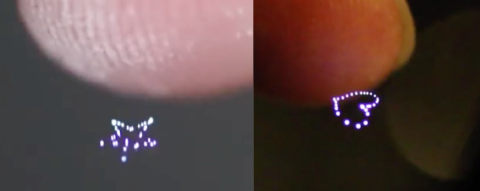
Images from Youtube video Fairy Lights in Femtoseconds: Aerial and Volumetric Graphics Rendered by Focused Femtosecond Laser Combined with Computational Holographic Fields.
Image Credit: Yoichi Ochia et al. (full video is embedded in this article).
Why Does One Laser Burn and One Create a Safe Tactile Sensation?
The maximum amount of energy that could be transferred to a voxel is equal to the energy of the laser pulse. Lasers are often defined by their power, the amount of energy they transfer per second measured in watts. A watt is defined as 1 joule of energy per 1 second. Imagine two pulse lasers, both able to transfer 1 watt or 1 joule per second. The nanosecond laser pulse lasts 40 billionths of a second, delivering 40 billionths of a joule of energy. This doesn’t sound like much, but it’s a lot of energy for such a small volume. The femtosecond laser pulse, on the other hand, lasts 40 quadrillionths of a second, delivering an equivalent amount of energy; one millionth of the nanosecond laser’s output.
The researches tested out the effects of the holograms they created for different pulse durations (between 30 fs and 100 fs), and for different exposure times (pulses occurred every millisecond over a duration between 50 ms and 6 seconds). The used pig leather rather than human tissue, and found that if the voxels were irradiated for longer than 2000 ms, the energy associated with the plasma would be enough to burn the leather.
With the femtosecond laser, the researchers were able to create multiple plasma voxels with one pulse and create voxels at a faster rate, leading to a well defined, bright 3D holographic image safe enough to touch, and feel.

While it sounds fancy, a galvano scanner is simply a set of mirrors that can be rotated electronically, allowing the laser beam to be steered to the proper voxel coordinates.
Image Credit: Digital Nature Group
The reason one can feel this type of hologram is that when plasma interacts with material, a shock wave is produced that then impinges on the material touching the plasma, causing a haptic (relating to the sense of touch) sensation.

Left: Just before contact is made. Right: Contact made with hologram.
Image Credit: Yoichi Ochia et al. (full video is embedded in this article).
A shock wave is most commonly associated with waves that propagate faster than the speed of sound. It is a discontinuous and abrupt change in pressure, temperature, and density in whatever medium it is traveling in, but the wave dissipates rapidly with distance from the source of the disturbance. For supersonic jets, a shock wave is created at the leading edge of the impinging surfaces (see image below at the nose of the plane and by the wings) and an expansion wave follows (see tail of jet). When the expansion wave and the shock wave meet, a sonic boom is heard as the two merge.
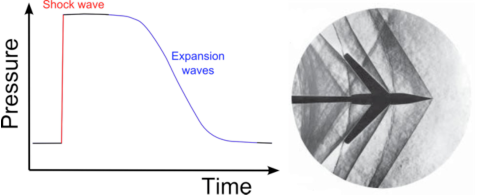
Left: In this pressure plot the leading edge the supersonic object creates the shock wave and the trailing edge creates the expansion wave.
Right: Photo showing different densities of air produced by shock waves on a supersonic body. At the rear the shock and expansion waves merge.
Holograms You Can Hear?
Plasma is a little noisy, and when you touch it, a sound is also produced. The researchers measured the sound level produced 20 mm from the hologram for various settings and found the maximum sound level without touching the plasma was 77.2 dB when using 40 fs pulses. This is on par with the kind of sounds we hear in everyday settings, and provides auditory as well as tactile feedback when the holograms are touched.
Below is a video created by the researchers explaining their research and showing a number of different ways to create 3D displays.
Future Research and Applications
Within the research article, the scientists note that one of the first tasks for future research and development would be to scale up the size of the aerial holograms; the scale is dependent on the optical devices used and the setup. Once the technology is sufficiently developed, there are a multitude of possible applications for tactile holograms, from informational displays to interactive communication devices. For example, a holographic keyboard projected by a future smartphone could allow you to type up a paper. In the classroom, an educator could use this technology to draw and manipulate vectors in three dimensions for their students.
References and Resources
1. Ochiai, Y. , et al. Fairy Lights in Femtoseconds: Aerial and Volumetric Graphics Rendered by Focused Femtosecond Laser Combined with Computational Holographic Fields.2. Ackerman, Evan, Femtosecond Lasers Create 3-D Midair Plasma Displays You Can Touch, Spectrum, IEEE, 26 June 2015
3. Doss, H.M., Holograms: From Credit Cards to Chocolate, Physics Central, 5 August 2014.
—H.M. Doss














